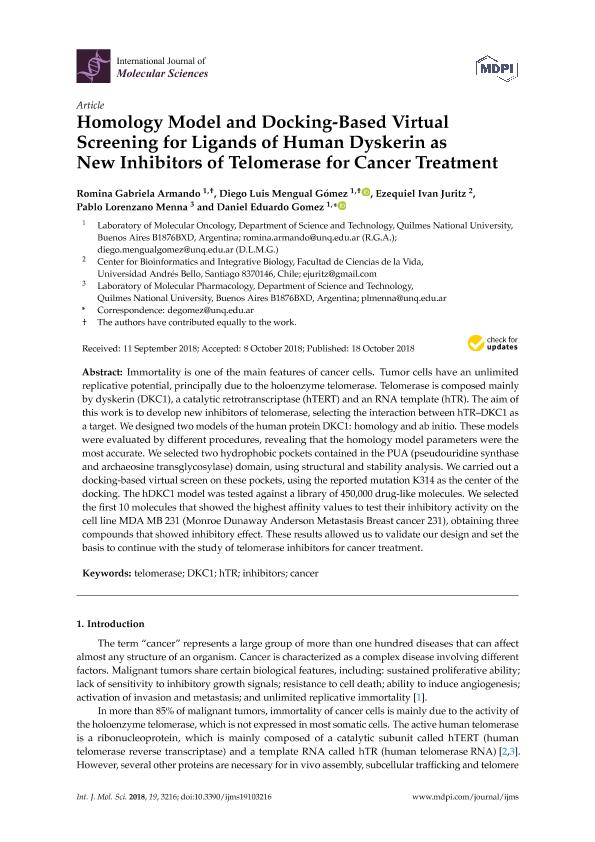Artículo
Homology model and docking-based virtual screening for ligands of human dyskerin as new inhibitors of telomerase for cancer treatment
Armando, Romina Gabriela ; Mengual Gómez, Diego Luis
; Mengual Gómez, Diego Luis ; Juritz, Ezequiel Ivan; Lorenzano Menna, Pablo
; Juritz, Ezequiel Ivan; Lorenzano Menna, Pablo ; Gomez, Daniel Eduardo
; Gomez, Daniel Eduardo
 ; Mengual Gómez, Diego Luis
; Mengual Gómez, Diego Luis ; Juritz, Ezequiel Ivan; Lorenzano Menna, Pablo
; Juritz, Ezequiel Ivan; Lorenzano Menna, Pablo ; Gomez, Daniel Eduardo
; Gomez, Daniel Eduardo
Fecha de publicación:
10/2018
Editorial:
Molecular Diversity Preservation International
Revista:
International Journal of Molecular Sciences
ISSN:
1422-0067
Idioma:
Inglés
Tipo de recurso:
Artículo publicado
Clasificación temática:
Resumen
Immortality is one of the main features of cancer cells. Tumor cells have an unlimited replicative potential, principally due to the holoenzyme telomerase. Telomerase is composed mainly by dyskerin (DKC1), a catalytic retrotranscriptase (hTERT) and an RNA template (hTR). The aim of this work is to develop new inhibitors of telomerase, selecting the interaction between hTR–DKC1 as a target. We designed two models of the human protein DKC1: homology and ab initio. These models were evaluated by different procedures, revealing that the homology model parameters were the most accurate. We selected two hydrophobic pockets contained in the PUA (pseudouridine synthase and archaeosine transglycosylase) domain, using structural and stability analysis. We carried out a docking-based virtual screen on these pockets, using the reported mutation K314 as the center of the docking. The hDKC1 model was tested against a library of 450,000 drug-like molecules. We selected the first 10 molecules that showed the highest affinity values to test their inhibitory activity on the cell line MDA MB 231 (Monroe Dunaway Anderson Metastasis Breast cancer 231), obtaining three compounds that showed inhibitory effect. These results allowed us to validate our design and set the basis to continue with the study of telomerase inhibitors for cancer treatment.
Palabras clave:
CANCER
,
DKC1
,
HTR
,
INHIBITORS
,
TELOMERASE
Archivos asociados
Licencia
Identificadores
Colecciones
Articulos(SEDE CENTRAL)
Articulos de SEDE CENTRAL
Articulos de SEDE CENTRAL
Citación
Armando, Romina Gabriela; Mengual Gómez, Diego Luis; Juritz, Ezequiel Ivan; Lorenzano Menna, Pablo; Gomez, Daniel Eduardo; Homology model and docking-based virtual screening for ligands of human dyskerin as new inhibitors of telomerase for cancer treatment; Molecular Diversity Preservation International; International Journal of Molecular Sciences; 19; 10; 10-2018; 1-16
Compartir
Altmétricas



